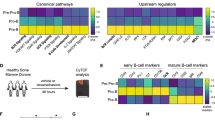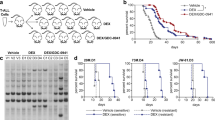Abstract
Glucocorticoid (GC)-induced apoptosis is essential in the treatment of acute lymphoblastic leukemia (ALL) and related malignancies. Pro- and anti-apoptotic members of the BCL2 family control many forms of apoptotic cell death, but the extent to which this survival ‘rheostat’ is involved in the beneficial effects of GC therapy is not understood. We performed systematic analyses of expression, GC regulation and function of BCL2 molecules in primary ALL lymphoblasts and a corresponding in vitro model. Affymetrix-based expression profiling revealed that the response included regulations of pro-apoptotic and, surprisingly, anti-apoptotic BCL2 family members, and varied among patients, but was dominated by induction of the BH3-only molecules BMF and BCL2L11/Bim and repression of PMAIP1/Noxa. Conditional lentiviral gene overexpression and knock-down by RNA interference in the CCRF-CEM model revealed that induction of Bim, and to a lesser extent that of BMF, was required and sufficient for apoptosis. Although anti-apoptotic BCL2 members were not regulated consistently by GC in the various systems, their overexpression delayed, whereas their knock-down accelerated, GC-induced cell death. Thus, the combined clinical and experimental data suggest that GCs induce both pro- and anti-apoptotic BCL2 family member-dependent pathways, with the outcome depending on cellular context and additional signals feeding into the BCL2 rheostat.
This is a preview of subscription content, access via your institution
Access options
Subscribe to this journal
Receive 12 print issues and online access
$259.00 per year
only $21.58 per issue
Buy this article
- Purchase on Springer Link
- Instant access to full article PDF
Prices may be subject to local taxes which are calculated during checkout






Similar content being viewed by others
References
Pui CH, Relling MV, Downing JR . Acute lymphoblastic leukemia. N Engl J Med 2004; 350: 1535–1548.
Laudet V, Gronemeyer H . The Nuclear Receptor Facts Book. Academic Press: London, 2002, 354–376.
Schmidt S, Rainer J, Ploner C, Presul E, Riml S, Kofler R . Glucocorticoid-induced apoptosis and glucocorticoid resistance: molecular mechanisms and clinical relevance. Cell Death Differ 2004; 11 (Suppl 1): S45–S55.
Schmidt S, Rainer J, Riml S, Ploner C, Jesacher S, Achmüller C et al. Identification of glucocorticoid response genes in children with acute lymphoblastic leukemia. Blood 2006; 107: 2061–2069.
Tissing WJ, den Boer ML, Meijerink JP, Menezes RX, Swagemakers S, van der Spek PJ et al. Genome-wide identification of prednisolone-responsive genes in acute lymphoblastic leukemia cells. Blood 2007; 109: 3929–3935.
Distelhorst CW . Recent insights into the mechanism of glucocorticosteroid-induced apoptosis. Cell Death Differ 2002; 9: 6–19.
Schaaf MJ, Cidlowski JA . Molecular mechanisms of glucocorticoid action and resistance. J Steroid Biochem Mol Biol 2002; 83: 37–48.
Planey SL, Litwack G . Glucocorticoid-induced apoptosis in lymphocytes. Biochem Biophys Res Commun 2000; 279: 307–312.
Strasser A . The role of BH3-only proteins in the immune system. Nat Rev Immunol 2005; 5: 189–200.
Ranger AM, Malynn BA, Korsmeyer SJ . Mouse models of cell death. Nat Genet 2001; 28: 113–118.
Almawi WY, Melemedjian OK, Jaoude MM . On the link between Bcl-2 family proteins and glucocorticoid-induced apoptosis. J Leukoc Biol 2004; 76: 7–14.
Labi V, Erlacher M, Kiessling S, Villunger A . BH3-only proteins in cell death initiation, malignant disease and anticancer therapy. Cell Death Differ 2006; 13: 1325–1338.
Hartmann BL, Geley S, Löffler M, Hattmannstorfer R, Strasser-Wozak EMC, Auer B et al. Bcl-2 interferes with the execution phase, but not upstream events, in glucocorticoid-induced leukemia apoptosis. Oncogene 1999; 18: 713–719.
Abrams MT, Robertson NM, Yoon K, Wickstrom E . Inhibition of glucocorticoid-induced apoptosis by targeting the major splice variants of BIM with siRNA and shRNA. J Biol Chem 2004; 279: 55809–55817.
Lu J, Quearry B, Harada H . p38-MAP kinase activation followed by BIM induction is essential for glucocorticoid-induced apoptosis in lymphoblastic leukemia cells. FEBS Lett 2006; 580: 3539–3544.
Salomons GS, Brady HJM, Verwijs-Janssen M, Van den Berg JD, Hart AAM, Van den Berg H et al. The Baxα:Bcl-2 ratio modulates the response to dexamethasone in leukaemic cells and is highly variable in childhood acute leukaemia. Int J Cancer 1997; 71: 959–965.
Wei G, Twomey D, Lamb J, Schlis K, Agarwal J, Stam RW et al. Gene expression-based chemical genomics identifies rapamycin as a modulator of MCL1 and glucocorticoid resistance. Cancer Cell 2006; 10: 331–342.
Wang Z, Malone MH, He H, McColl KS, Distelhorst CW . Microarray analysis uncovers the induction of the pro-apoptotic BH3-only protein Bim in multiple models of glucocorticoid induced apoptosis. J Biol Chem 2003; 278: 23861–23867.
Iglesias-Serret D, de FM, Santidrian AF, Coll-Mulet L, Cosialls AM, Barragan M et al. Regulation of the proapoptotic BH3-only protein BIM by glucocorticoids, survival signals and proteasome in chronic lymphocytic leukemia cells. Leukemia 2007; 21: 281–287.
Han J, Flemington C, Houghton AB, Gu Z, Zambetti GP, Lutz RJ et al. Expression of bbc3, a pro-apoptotic BH3-only gene, is regulated by diverse cell death and survival signals. Proc Natl Acad Sci USA 2001; 98: 11318–11323.
Casale F, Addeo R, D'Angelo V, Indolfi P, Poggi V, Morgera C et al. Determination of the in vivo effects of prednisone on Bcl-2 family protein expression in childhood acute lymphoblastic leukemia. Int J Oncol 2003; 22: 123–128.
Löffler M, Tonko M, Hartmann BL, Bernhard D, Geley S, Helmberg A et al. c-myc does not prevent glucocorticoid-induced apoptosis of human leukemic lymphoblasts. Oncogene 1999; 18: 4626–4631.
Czabotar PE, Lee EF, van Delft MF, Day CL, Smith BJ, Huang DCS et al. Structural insights into the degradation of Mcl-1 induced by BH3 domains. Proc Natl Acad Sci USA 2007; 104: 6217–6222.
Willis SN, Chen L, Dewson G, Wei A, Naik E, Fletcher JI et al. Proapoptotic Bak is sequestered by Mcl-1 and Bcl-xL, but not Bcl-2, until displaced by BH3-only proteins. Genes Dev 2005; 19: 1294–1305.
Claudio JO, Masih-Khan E, Tang H, Goncalves J, Voralia M, Li ZH et al. A molecular compendium of genes expressed in multiple myeloma. Blood 2002; 100: 2175–2186.
Green DR . Apoptotic pathways: ten minutes to dead. Cell 2005; 121: 671–674.
Kim H, Rafiuddin-Shah M, Tu HC, Jeffers JR, Zambetti GP, Hsieh JJ et al. Hierarchical regulation of mitochondrion-dependent apoptosis by BCL-2 subfamilies. Nat Cell Biol 2006; 8: 1348–1358.
Willis SN, Fletcher JI, Kaufmann T, van Delft MF, Chen L, Czabotar PE et al. Apoptosis initiated when BH3 ligands engage multiple Bcl-2 homologs, not Bax or Bak. Science 2007; 315: 856–859.
Willis SN, Adams JM . Life in the balance: how BH3-only proteins induce apoptosis. Curr Opin Cell Biol 2005; 17: 617–625.
Certo M, Del GMV, Nishino M, Wei G, Korsmeyer S, Armstrong SA et al. Mitochondria primed by death signals determine cellular addiction to antiapoptotic BCL-2 family members. Cancer Cell 2006; 9: 351–365.
Chen L, Willis SN, Wei A, Smith BJ, Fletcher JI, Hinds MG et al. Differential targeting of prosurvival Bcl-2 proteins by their BH3-only ligands allows complementary apoptotic function. Mol Cell 2005; 17: 393–403.
Villunger A, Michalak EM, Coultas L, Mullauer F, Bock G, Ausserlechner MJ et al. p53- and drug-induced apoptotic responses mediated by BH3-only proteins puma and noxa. Science 2003; 302: 1036–1038.
Erlacher M, Michalak EM, Kelly PN, Labi V, Niederegger H, Coultas L et al. BH3-only proteins Puma and Bim are rate-limiting for {gamma} -radiation and glucocorticoid-induced apoptosis of lymphoid cells in vivo. Blood 2005; 106: 4131–4138.
Rhein P, Scheid S, Ratei R, Hagemeier C, Seeger K, Kirschner-Schwabe R et al. Gene expression shift towards normal B cells, decreased proliferative capacity and distinct surface receptors characterize leukemic blasts persisting during induction therapy in childhood acute lymphoblastic leukemia. Leukemia 2007; 21: 897–905.
Alves NL, van Lier RA, Eldering E . Withdrawal symptoms on display: Bcl-2 members under investigation. Trends Immunol 2007; 28: 26–32.
Herr I, Gassler N, Friess H, Buchler MW . Regulation of differential pro- and anti-apoptotic signaling by glucocorticoids. Apoptosis 2007; 12: 271–291.
Schmidt S, Irving JA, Minto L, Matheson E, Nicholson L, Ploner A et al. Glucocorticoid resistance in two key models of acute lymphoblastic leukemia occurs at the level of the glucocorticoid receptor. FASEB J 2006; 20: 2600–2602.
Wang Z, Chen W, Kono E, Dang T, Garabedian MJ . Modulation of glucocorticoid receptor phosphorylation and transcriptional activity by a C-terminal-associated protein phosphatase. Mol Endocrinol 2007; 21: 625–634.
Szatmary Z, Garabedian MJ, Vilcek J . Inhibition of Glucocorticoid Receptor-mediated Transcriptional Activation by p38 Mitogen-activated Protein (MAP) Kinase. J Biol Chem 2004; 279: 43708–43715.
Bodwell JE, Webster JC, Jewell CM, Cidlowski JA, Hu JM, Munck A . Glucocorticoid receptor phosphorylation: overview, function and cell cycle-dependence. J Steroid Biochem Mol Biol 1998; 65: 91–99.
Acknowledgements
We thank Drs A Helmberg, K Janjetovic and Z Trajanoski for stimulating discussions, Drs D Huang, A Strasser and G Nolan for reagents, S Jesacher and Mag S. Lobenwein for technical assistance, and MK Occhipinti-Bender for editing. This work was supported by grants from the Austrian Science Fund (SFB-F021, P18747, P18571), the Austrian Ministry for Education, Science and Culture (GENAU-Ch.I.L.D.) and the European community (LSHS-CT-2004-503438, TRANSFOG).
Author information
Authors and Affiliations
Corresponding author
Additional information
Supplementary Information accompanies the paper on the Leukemia website (http://www.nature.com/leu)
Supplementary information
Rights and permissions
About this article
Cite this article
Ploner, C., Rainer, J., Niederegger, H. et al. The BCL2 rheostat in glucocorticoid-induced apoptosis of acute lymphoblastic leukemia. Leukemia 22, 370–377 (2008). https://doi.org/10.1038/sj.leu.2405039
Received:
Revised:
Accepted:
Published:
Issue Date:
DOI: https://doi.org/10.1038/sj.leu.2405039
Keywords
This article is cited by
-
Overcoming apoptotic resistance afforded by Bcl-2 in lymphoid tumor cells: a critical role for dexamethasone
Cell Death Discovery (2022)
-
Oxidant therapy improves adipogenic differentiation of adipose-derived stem cells in human wound healing
Stem Cell Research & Therapy (2021)
-
MARCH5 requires MTCH2 to coordinate proteasomal turnover of the MCL1:NOXA complex
Cell Death & Differentiation (2020)
-
Haploinsufficiency of NR3C1 drives glucocorticoid resistance in adult acute lymphoblastic leukemia cells by down-regulating the mitochondrial apoptosis axis, and is sensitive to Bcl-2 blockage
Cancer Cell International (2019)
-
Leukemic stem cell signatures identify novel therapeutics targeting acute myeloid leukemia
Blood Cancer Journal (2018)



